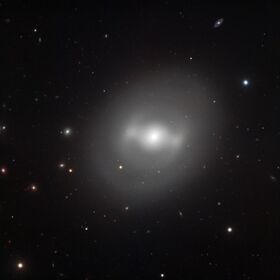Astronomy:NGC 936
| NGC 936 | |
|---|---|
 NGC 936 by the Very Large Telescope of ESO. | |
| Observation data (J2000 epoch) | |
| Constellation | Cetus |
| Right ascension | 02h 27m 37.4s[1] |
| Declination | −01° 09′ 22″[1] |
| Redshift | 1430 ± 4 km/s[1] |
| Distance | 67.7 ± 19.7 Mly (20.75 ± 6.05 Mpc)[1] |
| Apparent magnitude (V) | 10.2 |
| Characteristics | |
| Type | SB(rs)0+ [1] |
| Apparent size (V) | 4′.7 × 4′.1[1] |
| Other designations | |
| UGC 1929, PGC 9359[1] | |
NGC 936 is a barred lenticular galaxy in the constellation Cetus. It is at a distance of about 60 million light-years away from Earth. Its nucleus and prominent bar have high surface brightness. Because of the shape of the prominent bar, the nucleus and the ring of stars at the end of the barrel, the galaxy has been compared with the shape of a TIE fighter, from the Star Wars universe, and thus NGC 936 has been named Darth Vader’s Galaxy[2] or Darth Vader’s Starfighter.[3] By measuring the radial velocity of the disc, Kormendy found in 1986 that the disc is stable, which is the reason why it is so smooth.[4]
It was discovered by William Herschel on 6 January 1785, who classified it as a planetary nebula, because of its round shape.[3] One supernova (SN 2003gs) has been observed in NGC 936 and was typed as a peculiar Type Ia supernova, characterized by its fast evolution.[5][6] SN 2003gs peaked at magnitude 14.[7]
NGC 936 forms a pair with the spiral galaxy NGC 941, at 12.6' separation, however, the two galaxies do not interact.[8] This galaxy group (the NGC 936 group) also includes the galaxies NGC 955, UGC 01945 and IC 225. The group is associated with Messier 77 group.[9]
Gallery
References
- ↑ 1.0 1.1 1.2 1.3 1.4 1.5 1.6 "NASA/IPAC Extragalactic Database". Results for NGC 936. http://ned.ipac.caltech.edu/cgi-bin/nph-objsearch?objname=NGC+936.
- ↑ "Darth Vader's Galaxy, NGC 936". ESO. https://www.eso.org/public/images/potw1009a/.
- ↑ 3.0 3.1 Stephen James O'Meara (2011). Deep-Sky Companions: The Secret Deep, vol. 4. Cambridge University Press. pp. 43–45. ISBN 978-1-139-50007-4. https://books.google.com/books?id=v859bKO0A4gC&pg=PA45.
- ↑ Ronald J. Buta; Harold G. Corwin; Stephen C. Odewahn (2007). Atlas of Galaxies. Cambridge University Press. p. 119. ISBN 978-0-521-82048-6. https://books.google.com/books?id=g-P7dCbB5MEC&pg=PA119.
- ↑ Kevin Krisciunas (December 2009). "The fast declining Type Ia supernova 2003gs, and evidence for a significant dispersion in near-infrared absolute magnitudes of fast decliners at maximum light". The Astronomical Journal 138 (6): 1584–1596. doi:10.1088/0004-6256/138/6/1584. Bibcode: 2009AJ....138.1584K.
- ↑ Dovi Poznanski; Ryan Chornock; Peter E. Nugent; Joshua S. Bloom; Alexei V. Filippenko; Mohan Ganeshalingam; Douglas C. Leonard; Weidong Li et al. (January 2010). "An Unusually Fast-Evolving Supernova". Science 327 (5961): 58–60. doi:10.1126/science.1181709. PMID 19892941. Bibcode: 2010Sci...327...58P.
- ↑ List of Supernovae IAU Central Bureau for Astronomical Telegrams. Retrieved 29 December 2015.
- ↑ Sandage, A., Bedke, J. (1994), The Carnegie Atlas of Galaxies. Volume I, Carnegie Institution of Washington
- ↑ Dmitry Makarov; Igor Karachentsev (2011). "Galaxy groups and clouds in the local (z∼ 0.01) Universe". MNRAS 412 (4): 2498–2520. doi:10.1111/j.1365-2966.2010.18071.x. Bibcode: 2011MNRAS.412.2498M. http://www.sao.ru/hq/dim/groups/galaxies.dat. Retrieved 1 January 2016.
External links
- NGC 936 on WikiSky: DSS2, SDSS, GALEX, IRAS, Hydrogen α, X-Ray, Astrophoto, Sky Map, Articles and images
 |


